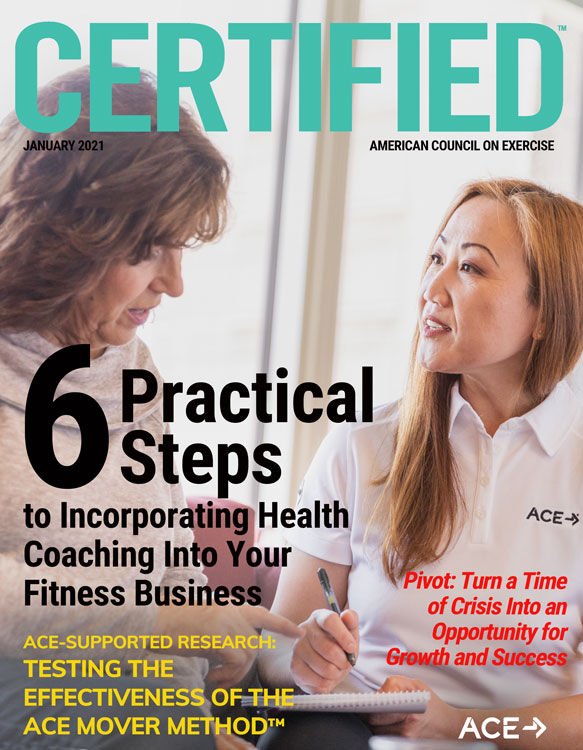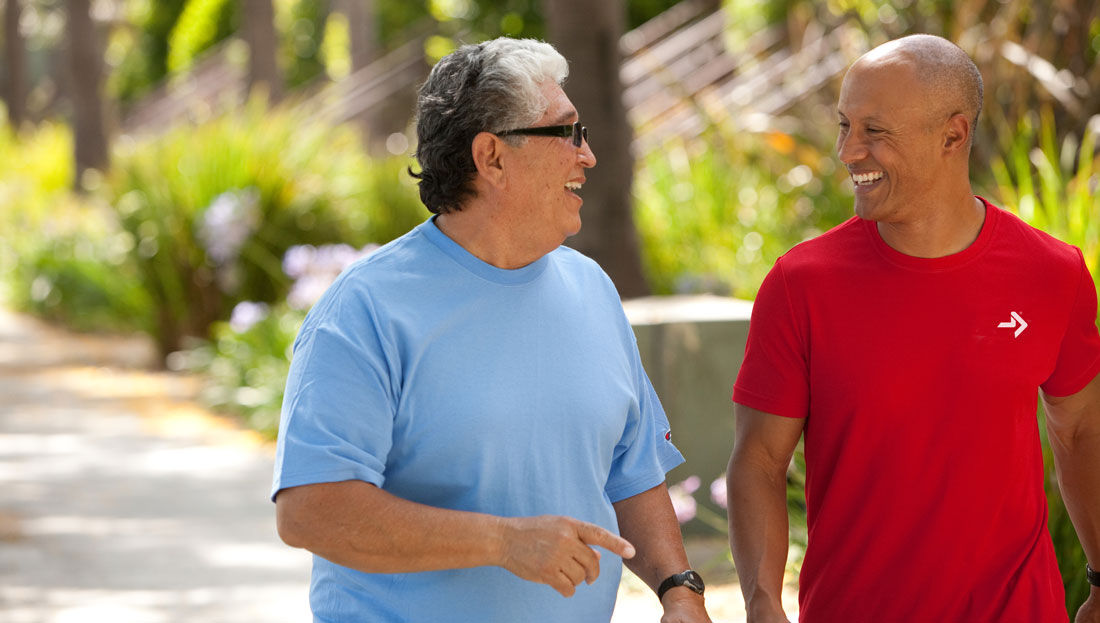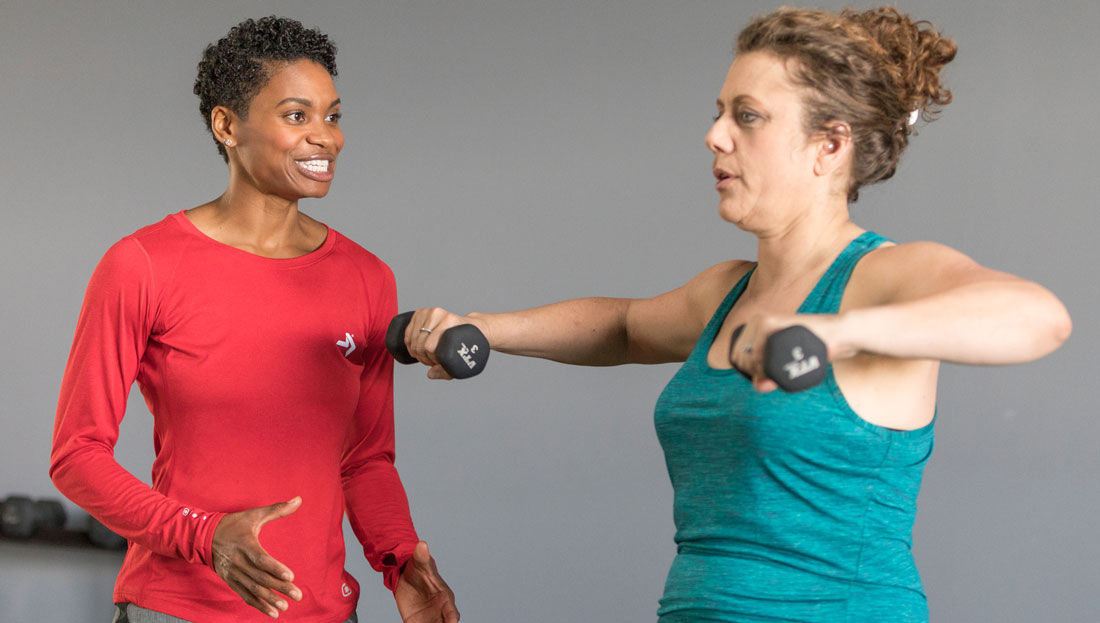
By Lance C. Dalleck, PhD, Angela M. Dalleck, MSc, and Bryant R. Byrd, BSc, with Daniel J. Green
What You Need to Know
This ACE-supported study provides preliminary evidence that the ACE Mover Method is a successful strategy for facilitating behavior and lifestyle changes. Among study participants, positive changes were seen across all of the behavior and lifestyle categories evaluated: less sedentary time, reduced stress and improved healthy eating habits. These results were driven purely by purposefully employing client-centered and empowering discussions that follow the ACE ABC Approach—Ask open-ended questions, Break down barriers and Collaborate.
The ACE Mover Method™ and the associated ACE ABC Approach™ are featured in ACE’s most recent textbook, The Exercise Professional’s Guide to Personal Training. The underlying philosophy behind the development of these tools is that the job of an exercise professional entails far more than an understanding of sets, repetitions and exercise programming. Exercise professionals have long recognized that perhaps the most important part of working with their clients centers on the need to empower them to make behavioral changes that can be incorporated into their lifestyles, align with their values and drive meaningful benefits to their health, fitness and overall quality of life.
The ACE Mover Method is founded on the following tenets:
- Each professional interaction is client-centered, with a recognition that clients are the foremost experts on themselves.
- Powerful open-ended questions and active listening are utilized in every session with clients.
- Clients are genuinely viewed as resourceful and capable of change.
Exercise professionals can apply the ACE Mover Method through the use of the ACE ABC Approach:
- Ask open-ended questions
- Break down barriers
- Collaborate
As described in The Exercise Professional’s Guide to Personal Training, every client–exercise professional interaction offers an opportunity to utilize coaching skills to help build rapport while positioning the client as an active partner in their behavior-change journey. Asking questions leads to the identification of goals and options for breaking down barriers, which in turn leads to collaborating on next steps. The ACE Mover Method provides the foundational skills for communicating effectively with clients, but it is not the equivalent of a health coaching certification. Exercise professionals should work in concert with other professionals, such as health coaches and registered dietitians and other allied health professionals, whenever appropriate, to take a team approach to improving their clients’ health and wellness.
Step 1 of this process involves asking powerful questions to identify what the client hopes to accomplish by working with an exercise professional and what, if any, physical activities the client enjoys. Open-ended questions are the key to sparking this discussion.
Step 2 involves asking more questions to discover what potential barriers may get in the way of the client reaching their specific goals. Questions like “What do you need to start doing now to move closer to your goals?” and “What do you need to stop doing that will enable you to reach your goals?” can be very revealing.
Step 3 is all about collaboration as the client and exercise professional work together to set SMART goals and establish specific steps to take action toward those goals. Allowing the client to lead the discussion of how to monitor and measure progress empowers them to take ownership of their personal behavior-change journey.
Dr. Lance Dalleck, PhD, who authored several chapters of The Exercise Professional’s Guide to Personal Training, shares that he had the following thought about the ACE Mover Method even as he worked on those chapters: “This all sounds great, but what would it look like in the real world, and what kind of outcomes could we expect?”
These are questions ACE wanted answers to as well, so they enlisted the help of Dr. Dalleck and his team of researchers in the High Altitude Exercise Physiology Program at Western Colorado University to examine the effectiveness of the ACE Mover Method at modifying healthy lifestyle behaviors.
The Study
The challenge of designing this study was to combine a research approach with how the ACE Mover Method would be implemented in a real-world setting, considering the client-centered and personalized approach at its heart. To meet this challenge, Dr. Dalleck used examples from the ACE textbook to train the research team to use the ACE ABC Approach when interacting with the study participants.
The team recruited 28 men and women aged 23 to 83 years old to participate in the study. All participants completed baseline and post-program assessments of anthropometric measures, cardiometabolic risk factors and maximal oxygen consumption (VO2max). At baseline, the talk test was conducted to identify the first and second ventilatory thresholds (VT1 and VT2) for each participant. In addition, assessments for lifestyle behavior and psychological outcomes were conducted before and after the study, including the International Physical Activity Questionnaire and the Simple Lifestyle Indicator Questionnaire.
All participants completed a 12-week personalized exercise training program based on the ACE Integrated Fitness Training® (ACE IFT®) Model. The research team designed and progressed an appropriate and safe personalized exercise program using the evidence-based ACE IFT Model guidelines for both Cardiorespiratory and Muscular Training. The student personal trainers coached participants during their exercise sessions, provided motivational support, engaged in spotting and corrected exercise technique. The details of the workout routine can be found in previous ACE-supported research on the ACE IFT Model.
Half of the participants (the ACE Mover Method group) received an intervention consisting of weekly client-centered sessions featuring the principles of the ACE Mover Method philosophy and ACE ABC Approach in addition to performing the personalized exercise program. These sessions were embedded within the normal exercise routine and personalized to each participant’s unique goals and needs. These conversations were collaborations aimed at positive lifestyle change in one or more of three areas (i.e., reduced sedentary time, healthy eating and stress reduction).
The other half of the participants (the Control group) performed the same workout routine, but without the application of the coaching skills defined in the ACE ABC Approach.
The Results
The physical and physiological characteristics of the participants are presented in Table 1. Cardiometabolic health and cardiorespiratory fitness improved in both the Control and ACE Mover Method groups over the course of the 12-week program. With the exception of waist circumference, the changes from baseline to post-program across these variables were similar in both groups.
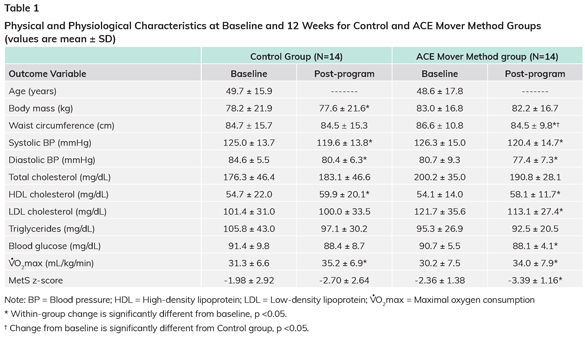
The researchers also looked at healthy behaviors and lifestyle changes in both groups (Table 2). Note that these scores were similar between the two groups at baseline. In the Control group, there were no statistically significant changes between baseline and post-program in any of the healthy behaviors and lifestyle change scores. In contrast, in the ACE Mover Method group, there were statistically significant improvements in all of these categories over the course of the 12 weeks.
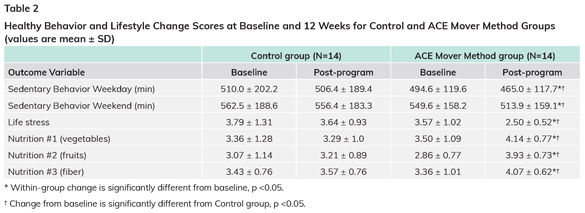
The Bottom Line
The findings of this study provide critical and encouraging preliminary evidence that the ACE Mover Method is a successful strategy for facilitating behavior and lifestyle changes. In fact, positive changes were seen across all of the behavior and lifestyle categories evaluated: less sedentary time, reduced stress and improved healthy eating habits.
It is well known that sitting time and stress negatively impact physiological health, so seeing improvements that bridge the elements presented in Tables 1 and 2 is extremely promising.
“Every interaction is an opportunity, even during usual training time,” Dr. Dalleck explains. By implementing the ACE Mover Method during your conversations with clients, you add value to your usual programming without increasing either the duration or intensity of the workouts. These results are driven purely by purposefully employing client-centered and empowering discussions that follow the ACE ABC Approach—Ask open-ended questions, Break down barriers and Collaborate.
Practical Tips for Making Every Interaction Client-centered
The research team offered the following key areas that exercise professionals can focus on when using the ACE Mover Method to facilitate fitness-related and health-behavior changes:

- Identifying each client’s readiness to change behavior and stage of behavioral change
- Fostering exercise adherence by creating positive exercise experiences that build self-efficacy
- Determining the need for, and appropriate selection and timing of, assessments and reassessments
- Designing, leading and modifying exercise programs based on each client’s current health and fitness status, needs and goals
- Fostering a sense of self-reliance to empower clients to take ownership of their lifestyle changes
- Utilizing appropriate strategies to help clients transition from one stage of behavior change to the next and implementing relapse-prevention strategies
- Helping clients transition from extrinsic motivation to intrinsic motivation
- Establishing realistic short- and long-term goals to prevent burnout, provide multiple opportunities for success and promote adherence
- Factoring a client’s external lifestyle behavior stressors into total fatigue to avoid training plateaus and prevent overtraining
- Empowering clients by helping them increase self-efficacy and knowledge to train on their own
- Supporting clients in making physical activity a life-long habit





 by
by 